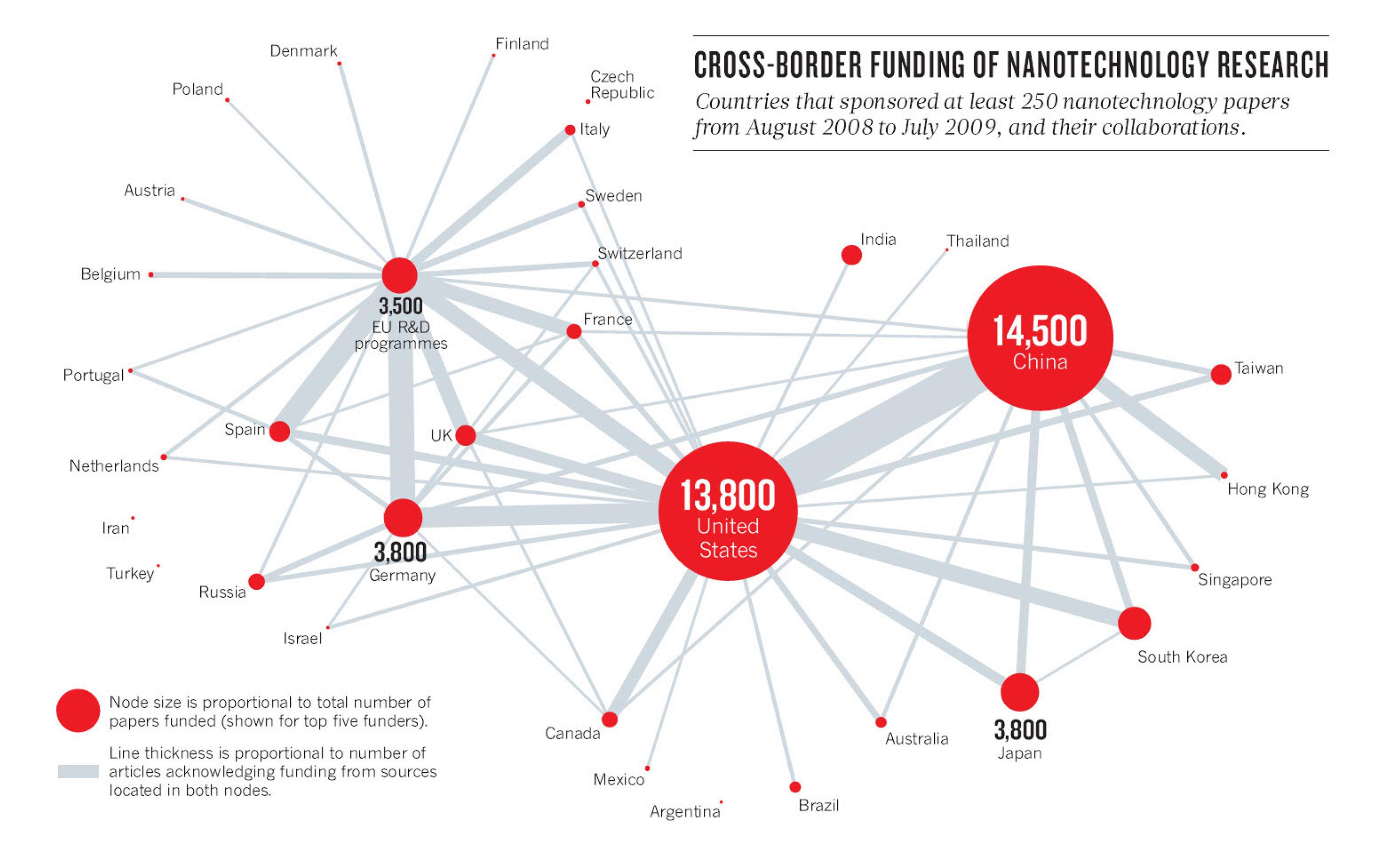
Despite their initial focus on national economic competitiveness, the nanotechnology research initiatives now funded by more than 60 countries have become increasingly collaborative, with nearly a quarter of all papers co-authored by researchers across borders.
Researchers from the two leading producers of nanotechnology papers — China and the United States — have become each nation’s most frequent international co-authors. Though Chinese and U.S. researchers now publish roughly the same number of nanotechnology papers, the U.S. retains a lead in the quality of publications — as measured by the number of early citations.
“Despite ten years of emphasis by governments on national nanotechnology initiatives, we find that patterns of nanotechnology research collaboration and funding transcend country boundaries,” said Phillip Shapira, study co-author and a professor in the School of Public Policy at the Georgia Institute of Technology. “For example, we found that U.S. and Chinese researchers have developed a relatively high level of collaboration in nanotechnology research. Each country is the other’s leading collaborator in nanotechnology R&D.”
The findings were part of a new study of nanotechnology publishing reported Dec. 2 in the online edition of the journal Nature. The research was sponsored by the National Science Foundation-supported Center for Nanotechnology in Society at Arizona State University (CNS-ASU).
Sparked by programs such as the National Nanotechnology Initiative (NNI) in the United States, leading industrial nations have launched nanotechnology research programs that invested more than $8 billion in public funds in 2008 alone. China, Germany, Japan and Korea are among the many countries that have launched major governmental programs to develop their national nanotechnology capabilities as part of efforts to boost future economic growth.
“There is widespread anticipation that nanotechnology will be a critical component in addressing global challenges in such areas as energy, environment, health care, security and sustainability,” explained Shapira, who is also a professor of innovation at the University of Manchester. “At the same time, nanotechnology may be a key driver in the next wave of technology-led economic growth and investment. Governments around the world are hoping that their often massive investments in nanotechnology R&D will lead not only to economic, but also to significant societal returns.”
Though the revolutionary advances that nanotechnology promises are still off into the future, Shapira noted that the investments made so far have led to “a noticeable shift toward innovation in the past few years as companies are beginning to market a wide range of products and devices whose performance has been enhanced by nanoscale science and engineering.”
The study was conducted by Shapira and collaborator Jue Wang, an assistant professor at Florida International University. It used data mining techniques to study funding acknowledgements that have been available since 2008 in the Web of Science — one of the leading international databases of scientific publications. Shapira and Wang analyzed more than 91,000 papers published worldwide between August 2008 and July 2009.
They found that although researchers from 152 nations were represented in the survey, just 15 countries represented 90 percent of the papers. The top four countries by author affiliation were the United States (23 percent), China (22 percent), Germany (8 percent) and Japan (8 percent). Papers authored by researchers from more than one nation – which constituted 23 percent of those examined – were assigned to more than one country.
Though the United States and China now produce approximately the same number of papers, the U.S. maintains significant advantages.
“Compared with Chinese counterparts, papers authored by U.S. researchers still have a substantial lead in terms of citation quality and U.S. corporate activity in nanotechnology innovation remains rather larger,” Shapira said. “However, Chinese quality is improving and an increasing number of Chinese companies are becoming engaged in developing and commercializing nano-enabled products.”
The study analyzed the funding sources cited in a sub-set of 61,300 papers that were supported by grants. The National Natural Science Foundation of China was the top funder, with more than 10,200 publications representing 16.7 percent of all sponsored papers. Second was the U.S. National Science Foundation with 6,700 publications. Rounding out the top five were the Ministry of Science and Technology of China, the European Union’s R&D programs, and the U.S. Department of Health and Human Services — which includes the National Institutes of Health.
Eight sponsors saw at least 10 percent of the papers they funded garner five or more citations within a year of publication — the study’s definition of an “early-citation” paper. This group is led by four U.S. agencies: the National Institutes of Health, the National Science Foundation, the Department of Energy, and the Department of Defense.
About three percent of U.S. papers reported co-funding from the Chinese National Natural Science Foundation, while a similar proportion of Chinese papers report co-funding from the U.S. National Science Foundation.
“Although these numbers are still low relative to purely nationally-funded papers, they signal a significant trend as China has taken over from European countries as America’s leading international collaborator by volume in nanotechnology research,” Shapira explained. “China’s scientific relationships do, of course, extend beyond the United States, and China has emerged as the hub for nanotechnology research collaboration in Asia.”
The study also found that sponsors concentrating their funding in fewer institutions had lower research impact as measured by early citation counts. “Our starting hypothesis is that when groups from multiple institutions vie for funding, there is increased competition, review processes are less partial, and there are more opportunities to select the most improving projects,” Shapira explained.
With increasing budget pressures, growth in nanotechnology funding appears unlikely. How should countries invest their limited funding for greatest benefit?
“One way would be to foster more high-quality international collaborations, perhaps by opening funding competitions to international researchers and by offering travel and mobility awards for domestic researchers to increase alliances with colleagues in other countries,” the researchers suggested in their paper.



